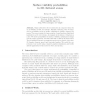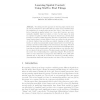108
click to vote
ECCV
2008
Springer
16 years 2 months ago
2008
Springer
This paper proposes a metric learning based approach for human activity recognition with two main objectives: (1) reject unfamiliar activities and (2) learn with few examples. We s...
ECCV
2008
Springer
16 years 2 months ago
2008
Springer
Many methods for 3D reconstruction in computer vision rely on probability models, for example, Bayesian reasoning. Here we introduce a probability model of surface visibilities in ...
ECCV
2008
Springer
16 years 2 months ago
2008
Springer
This paper introduces a novel method for recovering both the light directions and camera poses from a single sphere. Traditional methods for estimating light directions using spher...
111
click to vote
ECCV
2008
Springer
16 years 2 months ago
2008
Springer
The sliding window approach of detecting rigid objects (such as cars) is predicated on the belief that the object can be identified from the appearance in a small region around the...
102
click to vote
ECCV
2008
Springer
16 years 2 months ago
2008
Springer
Abstract. We present a technique for learning the parameters of a continuousstate Markov random field (MRF) model of optical flow, by minimizing the training loss for a set of grou...
112
click to vote
ECCV
2008
Springer
16 years 2 months ago
2008
Springer
In this paper, we present a robust face alignment system that is capable of dealing with exaggerating expressions, large occlusions, and a wide variety of image noises. The robustn...
117
click to vote
ECCV
2008
Springer
16 years 2 months ago
2008
Springer
We present an efficient multi stage approach to detection of deformable objects in real, cluttered images given a single or few hand drawn examples as models. The method handles de...
126
click to vote
ECCV
2008
Springer
16 years 2 months ago
2008
Springer
Viewpoint invariant pedestrian recognition is an important yet under-addressed problem in computer vision. This is likely due to the difficulty in matching two objects with unknown...
129
Voted
ECCV
2008
Springer
16 years 2 months ago
2008
Springer
Abstract. This paper presents a novel probabilistic approach to integrating multiple cues in visual tracking. We perform tracking in different cues by interacting processes. Each p...
102
Voted
ECCV
2008
Springer
16 years 2 months ago
2008
Springer
Abstract. A new approach, called Collective Shape Difference Classifier (CSDC), is proposed to improve the accuracy and computational efficiency of 3D face recognition. The CSDC le...


